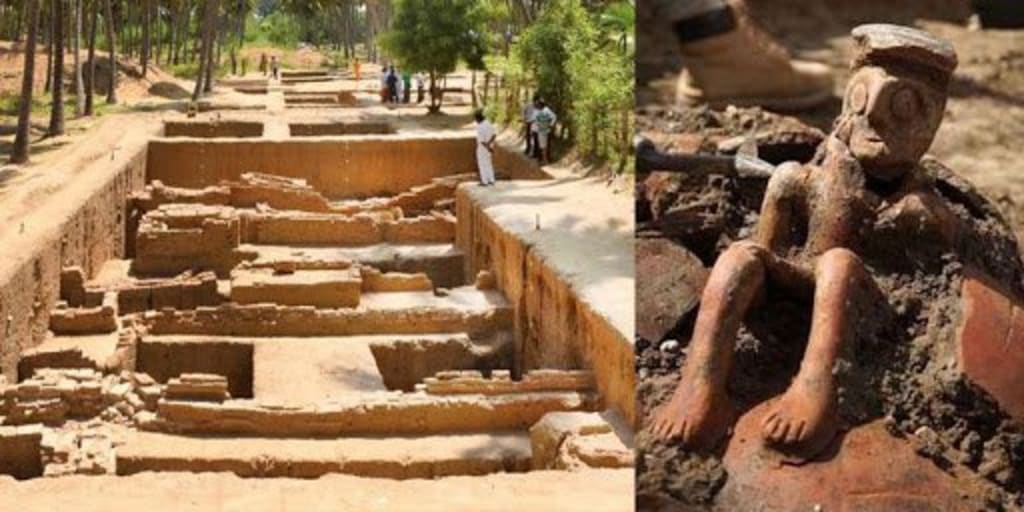
The Keeladi civilization, also known as the Keezhadi civilization, is an ancient civilization that flourished in the Tamil Nadu region of South India during the Sangam period, which is estimated to have been between the 6th century BCE and the 3rd century CE. The Keeladi archaeological site, located in the Sivagangai district of Tamil Nadu, is the site of an extensive excavation that has yielded a wealth of information about this civilization.
The discovery of the Keeladi civilization has been a significant breakthrough in our understanding of ancient South Indian history. The excavation at Keeladi has revealed a highly advanced urban civilization that existed in South India during the Sangam period. The excavation has yielded a range of artifacts, including pottery, jewelry, weapons, and inscriptions that provide valuable insights into the social, economic, and cultural life of the Keeladi civilization.
The Keeladi civilization was a highly advanced society with a sophisticated urban culture. The site has revealed evidence of a highly organized system of governance, including a complex drainage system and an elaborate network of streets and buildings. The civilization also appears to have had a highly developed system of writing, although the script has yet to be deciphered.

The Keeladi civilization was a predominantly agrarian society with a strong focus on agriculture. The site has revealed evidence of advanced irrigation systems, indicating that the Keeladi civilization had a high level of expertise in the management of water resources. The site also contains evidence of specialized crafts and industries, including iron smelting, weaving, and bead making.
The excavation has also provided valuable insights into the social and cultural life of the Keeladi civilization. The discovery of inscriptions and artifacts such as pottery and jewelry suggests that the Keeladi civilization was a society with a high degree of social stratification. The site has yielded evidence of a range of crafts and industries, including metalworking, bead making, and weaving. The Keeladi civilization appears to have been a highly cosmopolitan society with strong links to other regions of South India and beyond.
The discovery of the Keeladi civilization has also challenged long-held beliefs about the cultural and economic dominance of the northern Indus Valley civilization and its successors. The excavation at Keeladi has revealed a highly developed civilization that existed in South India during the Sangam period, which was contemporaneous with the Mauryan empire in the north. This has led to a re-evaluation of the cultural and economic history of ancient India, and a recognition of the importance of South India in the development of Indian civilization.
The Keeladi civilization was a highly advanced society with a sophisticated urban culture. The site has revealed evidence of a highly organized system of governance, including a complex drainage system and an elaborate network of streets and buildings. The civilization also appears to have had a highly developed system of writing, although the script has yet to be deciphered.
The excavation has yielded a range of artifacts that provide valuable insights into the daily life of the Keeladi civilization. The discovery of pottery, jewelry, weapons, and inscriptions suggests that the Keeladi civilization was a society with a high degree of social stratification. The site has yielded evidence of a range of crafts and industries, including metalworking, bead making, and weaving. The Keeladi civilization appears to have been a highly cosmopolitan society with strong links to other regions of South India and beyond.
The Keeladi civilization was a predominantly agrarian society with a strong focus on agriculture. The site has revealed evidence of advanced irrigation systems, indicating that the Keeladi civilization had a high level of expertise in the management of water resources. The site also contains evidence of specialized crafts and industries, including iron smelting, weaving, and bead making.
The discovery of the Keeladi civilization has also shed light on the cultural and artistic achievements of the ancient Tamil society. The site has yielded a range of artifacts, including inscriptions, pottery, and jewelry that provide valuable insights into the literary and artistic traditions of the Keeladi civilization. The site has revealed evidence of a highly developed system of writing, although the script has yet to be deciphered.
The Keeladi civilization appears to have been a highly literate society, with a rich literary tradition that has been described in Tamil literature as the Sangam period. The Sangam period is known for its literary works, which include the famous Tamil epics Silappathikaram and Manimekalai. The excavation at Keeladi has revealed evidence of a sophisticated system of literature and poetry, including inscriptions that suggest the existence of a formal system of education.
The Keeladi civilization also appears to have been a society with a rich artistic tradition. The site has yielded a range of pottery and jewelry, which indicate a highly developed artistic style. The pottery found at Keeladi is decorated with intricate designs, while the jewelry is made of gold, silver, and precious stones, suggesting that the Keeladi civilization was a society with a high degree of artistic and cultural sophistication.
The Keeladi excavation has also revealed evidence of the existence of a sophisticated system of governance. The site contains evidence of a complex drainage system, which indicates a high degree of urban planning and organization. The site also contains evidence of a range of public buildings, including granaries, indicating a centralized system of governance that was responsible for the management of food resources.
The Keeladi excavation has challenged long-held beliefs about the cultural and economic history of ancient India. The excavation has revealed a highly developed civilization that existed in South India during the Sangam period, which was contemporaneous with the Mauryan empire in the north. This has led to a re-evaluation of the cultural and economic history of ancient India, and a recognition of the importance of South India in the development of Indian civilization.
The discovery of the Keeladi civilization has also raised important questions about the preservation and conservation of India's archaeological heritage. The site at Keeladi was almost destroyed in the 1970s due to construction activities, highlighting the need for greater awareness and protection of India's ancient archaeological sites.
In conclusion, the Keeladi civilization is an important discovery that has significantly expanded our understanding of the history of South India and the ancient Tamil society. The excavation at Keeladi has revealed a highly advanced urban civilization that existed in South India during the Sangam period. The discovery of inscriptions, pottery, and jewelry, as well as evidence of a complex system of governance and a sophisticated literary and artistic tradition, has challenged long-held beliefs about the cultural and economic dominance of the northern Indus Valley civilization and its successors. The Keeladi excavation has also highlighted the importance of the preservation and conservation of India's archaeological heritage.





Comments
There are no comments for this story
Be the first to respond and start the conversation.